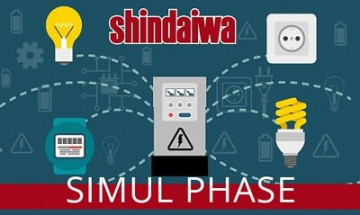
The power of an electric generator is a crucial parameter that affects the choice of the device model. Typically, power is divided into primary and standby (nominal and maximum), and decisions are based on them. The generator can efficiently operate for a prolonged period at a load ranging from 30% to 70% of its maximum (standby) power (note that overloads are allowed for no more than 1 hour within a 12-hour period).
With a load close to the standby power, the generator can function for a limited time, depending on the degree of engine heating. Overloading is not permitted, as the consequences can be critical, ranging from temporary malfunction to severe breakdowns. A load less than 30% of the nominal (primary) power negatively affects the generator's performance and can cause significant damage, leading to device failure.
If it is necessary to select the generator capacity.
To correctly select the generator's power, follow these steps:
- Determine all the values of Starting Current Coefficients (SCC) and power (kW) for the devices you plan to connect;
- Calculate the sum (∑P in kW with SCC) of the powers of all the devices powered by the generator;
- Increase the obtained value of P by 10-20% (for a margin);
- Verify the compatibility of the final power value ∑P with the generator's capacity.

Where to find values of generator power and SCC.
The power values of the devices to be connected to the electric generator are usually presented in their technical data sheets. Additionally, these values can be found in user manuals or on information plates on the device's housing.
To calculate the generator's power correctly, it's essential to take into account the starting currents. In some cases, they can significantly affect the consumed power. All electrical devices can be divided into resistive and inductive. Resistive devices convert active power into heat or light, e.g., electric heaters, light bulbs, stoves, and similar items. Their SCC is close to 1.
Inductive devices operate with electric motors, such as refrigerators, compressors, drills. During the startup of these devices, their starting current can temporarily increase the power several times. Therefore, when turning on inductive electric devices, the generator's power reserve is required. At the initial moment, the starting current coefficients can vary from 1.2 to 3.5 and even up to 7.
Calculating the total power of all consumers, considering the reserve.
The calculated generator power ∑P, in a preliminary estimation, is determined as the sum of the powers of consumers (which will operate simultaneously), taking into account their starting current coefficients. For example, when including a refrigerator with a power of 200 W and a starting current coefficient of 3, the calculation includes the multiplication result 200*3, total value 600 W. The same method is applied to each device's data (see the example below).
The obtained sum (∑P) should be increased by 10%-20%. The reserve will compensate for inaccuracies in calculations, create opportunities for increasing the power of electricity consumers in the future, and allow you to power a device that was not considered when purchasing the power station.
Verification of the selected generator power range.
Before definitively determining the required generator power, it is essential to check its optimality. As known, an electric generator operates optimally when the connected load falls within the range of 40% to 80% of the rated power. Accordingly, the amount ∑P must fall within the specified range.
It should be noted that the generator loses its operability when operating at its maximum capacity and at very low loads. If the calculation involves many electrical devices, and not all of them are used constantly, you can reduce the power reserve to 10-12%.
Of course, if the generator capacity calculation is made by a specialist, who will take into account additional capabilities of the generator, consumers, operational features, wiring. To take into account individual features of a particular scheme in which the generator is included, it is better to entrust the process to professionals. For example, by consulting through the feedback form on MVN website. However, the principle of calculating the required generator capacity described above simplifies the task of unit selection.
Example of Power Calculation for Generator Selection.
To quickly determine the power of a generator for a repair team, it is necessary to identify the equipment list. The equipment set for such a team may include: Drill 800 W, Rotary Hammer 1200 W, Edge Trimming Machine 500 W, Turbine 1100 W, Inverter 700 W; Concrete Mixer 1200 W; 2 Floodlights 150 W each.
Multiply the power of each device by the averaged values of starting current (SCC) for the respective devices. We get: Drill 800 W * 1.2 = 960 W; Rotary Hammer 1200 W * 1.2 = 1440 W; Edge Trimming Machine 500 * 1.2 = 680; Turbine 1100 * 1.3 = 1430; Inverter 700 * 2.0 = 1400; Concrete Mixer 1200 * 3.5 = 4200; Floodlight 150 W * 2 pcs * 1 = 300.
Calculate the sum of the computed values (see calculation ∑P): 960 + 1440 + 680 + 1430 + 1400 + 4200 + 300 = 10,410 W. Considering that an unaccounted power tool may need to be connected, increase the obtained value by 10%. As a result, the calculated value will be - 11,451 W (11.5 kW / 13.7 kVA).
From the above, we can conclude that to ensure the operation of a hypothetical team, a generator with a power rating of 12 kW (14.4 kVA) to 15 kW (18 kVA) will be required. A suitable device could be the Shindaiwa DGK15F generator (12 kW / 14.4 kVA) with the capability of simultaneously connecting 1-phase and 3-phase devices (Simul Phase technology).
This is a rather rough calculation. It provides approximate boundaries for the range of generator models that may be suitable for the given task.
MVN-machinery - Supply and Service of Diesel welders and Generators in the USA







